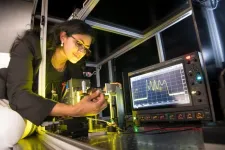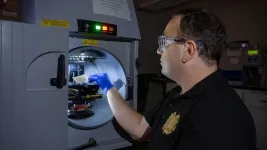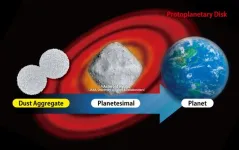(Press-News.org) LA JOLLA, CA — Scripps Research scientists have developed a machine-learning system—a type of artificial intelligence (AI) application—that can track the detailed evolution of epidemic viruses and predict the emergence of viral variants with important new properties.
In a paper in Cell Patterns on July 21, 2023, the scientists demonstrated the system by using data on recorded SARS-CoV-2 variants and COVID-19 mortality rates. They showed that the system could have predicted the emergence of new SARS-CoV-2 “variants of concern” (VOCs) ahead of their official designations by the World Health Organization (WHO). Their findings point to the possibility of using such a system in real-time to track future viral pandemics.
“There are rules of pandemic virus evolution that we have not understood but can be discovered, and used in an actionable sense by private and public health organizations, through this unprecedented machine-learning approach,” says study senior author William Balch, PhD, professor in the Department of Molecular Medicine at Scripps Research.
The co-first authors of the study were Salvatore Loguercio, PhD, a staff scientist in the Balch lab at the time of the study, and currently a staff scientist at the Scripps Research Translational Institute; and Ben Calverley, PhD, a postdoctoral research associate in the Balch lab.
The Balch lab specializes in the development of computational, often AI-based methods to illuminate how genetic variations alter the symptoms and spread of diseases. For this study, they applied their approach to the COVID-19 pandemic. They developed machine-learning software, using a strategy called Gaussian process-based spatial covariance, to relate three data sets spanning the course of the pandemic: the genetic sequences of SARS-CoV-2 variants found in infected people worldwide, the frequencies of those variants, and the global mortality rate for COVID-19.
“This computational method used data from publicly available repositories,” Loguercio says. “But it can be applied to any genetic mapping resource.”
The software enabled the researchers to track sets of genetic changes appearing in SARS-CoV-2 variants around the world. These changes—typically trending towards increased spread rates and decreased mortality rates—signified the virus’ adaptations to lockdowns, mask wearing, vaccines, increasing natural immunity in the global population, and the relentless competition among SARS-CoV-2 variants themselves.
“We could see key gene variants appearing and becoming more prevalent, as the mortality rate also changed, and all this was happening weeks before the VOCs containing these variants were officially designated by the WHO,” Balch says.
He and his team showed that they could use this SARS-CoV-2 tracking system as an early warning “anomaly detector” for gene variants associated with significant changes in viral spread and mortality rates.
“One of the big lessons of this work is that it is important to take into account not just a few prominent variants, but also the tens of thousands of other undesignated variants, which we call the ‘variant dark matter,’” Balch says.
A similar system could be used to track the detailed evolution of future viral pandemics in real time, the researchers note. In principle, it would enable scientists to predict changes in a pandemic’s trajectory—for example, big increases in infection rates—in time to adopt appropriate public health countermeasures.
Balch and his colleagues also envision the use of their approach to better understand virus biology and thereby enhance the development of treatments and vaccines. Currently they are using their AI system to uncover key details of how different SARS-CoV-2 proteins worked together in the evolution of the pandemic.
“This system and its underlying technical methods have many possible future applications,” Calverley says.
“Understanding the Host-Pathogen Evolutionary Balance through Gaussian Process Modelling of SARS-CoV-2” was co-authored by Salvatore Loguercio, Ben Calverley, Chao Wang, Daniel Shak, Pei Zhao, Shuhong Sun, Scott Budinger, and William Balch.
About Scripps Research
Scripps Research is an independent, nonprofit biomedical institute ranked one of the most influential in the world for its impact on innovation by Nature Index. We are advancing human health through profound discoveries that address pressing medical concerns around the globe. Our drug discovery and development division, Calibr, works hand-in-hand with scientists across disciplines to bring new medicines to patients as quickly and efficiently as possible, while teams at Scripps Research Translational Institute harness genomics, digital medicine and cutting-edge informatics to understand individual health and render more effective healthcare. Scripps Research also trains the next generation of leading scientists at our Skaggs Graduate School, consistently named among the top 10 US programs for chemistry and biological sciences. Learn more at www.scripps.edu.
END
Scripps Research scientists develop AI-based tracking and early-warning system for viral pandemics
Machine-learning system effectively predicts emergence of prominent variants
2023-07-21
ELSE PRESS RELEASES FROM THIS DATE:
University of Liverpool scientists make promising discovery in fight against breast cancer
2023-07-21
Researchers from the University of Liverpool have created a biomedical compound that has the potential to stop the spread of breast cancer. A recently published paper details these early findings.
Scientists from the Chemistry and Biochemistry Departments at the University of Liverpool and Nanjing Medical School in China have discovered a possible way to block proteins produced in the body when a patient has cancer and which causes its spread to other parts of the body. This process, called metastasis, is largely responsible for patient deaths.
The major problem hindering the successful treatment of commonly occurring cancers is not the primary tumour which can usually be removed by ...
Male crickets court females in unison – unless rivals get too close
2023-07-21
Male crickets sing in unison to attract females – but stop singing if a rival gets too close, new research shows.
University of Exeter scientists watched more than 100 male field crickets, and measured how often they chirped at the same time (called “singing overlap”).
Singing by males one to five metres away from a listening male had a “stimulatory effect”, leading to a chorus of crickets singing together.
However, males were less likely to sing if another cricket chirped within one metre – possibly because the territorial insects instead chose to fight ...
Some people’s brain function still affected by Long COVID years after infection
2023-07-21
Some people’s brain function still affected by Long COVID years after infection
UK researchers have found that people with longer-term COVID-19 symptoms including brain fog showed reduced performance in tasks testing different mental processes up to two years after infection with the virus.
Researchers from King’s College London looked at whether infection with COVID-19 affected performance in two rounds of online cognitive testing that took place in 2021 and 2022. Data was collected for over 3,000 participants of the COVID Symptom Study Biobank study, across 12 tasks that tested memory, attention, reasoning, processing speed and ...
MASER technology scientist awarded funding for new research
2023-07-21
A scientist from Northumbria University has been awarded almost half a million pounds to develop a new technology which could transform deep-space communication, radio astronomy, medical imaging and airport security scanning.
Dr Juna Sathian has received a grant from the government’s Engineering & Physical Sciences Research Council (EPSRC) to develop a new type of MASER (Microwave Amplification by Stimulated Emission of Radiation) device.
The forerunner to LASERs, MASERs were first discovered in the 1950s. But there has been ...
Researchers decipher the secrets of Benjamin Franklin’s paper money
2023-07-21
Benjamin Franklin may be best known as the creator of bifocals and the lightning rod, but a group of University of Notre Dame researchers suggest he should also be known for his innovative ways of making (literal) money.
During his career, Franklin printed nearly 2,500,000 money notes for the American Colonies using what the researchers have identified as highly original techniques, as reported in a study published this week in the Proceedings of the National Academy of Sciences.
The research team, led by Khachatur Manukyan, an associate research professor ...
KIPA potentially predicts chemotherapy response in triple negative breast cancer
2023-07-21
Researchers at Baylor College of Medicine and collaborating institutions are developing a strategy to predict the response of triple negative breast cancer (TNBC) to chemotherapy, which would be a valuable tool for physicians deciding on the treatment with better probability of success on an individual basis. The study appears in Cancer Research Communications, a journal of the American Association for Cancer Research.
“Multiple research innovations in cancer diagnostics are on display in this work,” said co-corresponding author Dr. Matthew Ellis, member of the Lester and Sue Smith Breast Center and the Dan ...
On the hunt for strangeness
2023-07-21
NEWPORT NEWS, VA – Peter Hurck has been searching for strange particles, named such because they contain strange quarks, since beginning work on his Ph.D. As the 2023 Jefferson Science Associates (JSA) Postdoctoral Prize winner, he’ll continue conducting data analyses to identify strange particles and learn about their properties.
Many of these experiments that contribute to the data Hurck is analyzing are conducted at the U.S. Department of Energy's Thomas Jefferson National Accelerator Facility, which is managed and operated by JSA.
“Strangeness hasn't been studied as much because it's quite ...
ASBMB expresses concerns on proposed NIH budget cuts
2023-07-21
On July 19, the American Society for Biochemistry and Molecular Biology released a statement expressing concerns on the National Institutes of Health budget proposed in the House Labor, Health and Human Services, Education and Related Agencies funding bill. The bill allocates only $44.7 billion for NIH, which represents a 6.4% decrease from fiscal year 2023 levels and would have detrimental repercussions for the National Institute of Allergy and Infectious Diseases, the National Institute of Neurological Diseases and Stroke, the National Cancer Institute and the National Institute ...
To stick or to bounce: Size determines the stickiness of cosmic dust aggregates
2023-07-21
Microparticle dust aggregates, which are thought to play a role in the formation of new planets, are less likely to stick together after a collision when the aggregates are larger.
Current evidence suggests that microparticles of cosmic dust collide and stick together to form larger dust aggregates that may eventually combine and develop into planets. Numerical models that accurately characterize the conditions required for colliding microparticle aggregates to stick together, rather than bounce apart, are therefore ...
Long-term changes in waves and storm surges have not impacted global coastlines
2023-07-21
Changes in ocean wave and storm conditions have not caused long-term impacts on sandy coastlines in the past 30 years, a new study has found.
Published today in Scientific Reports, the study draws on data from 30 years of global satellite and model studies to investigate whether changes in ocean wave conditions will have an impact on the stability of coastal environments.
The compounding effect of climate change driven variations in waves, storm surge and sea level rise is projected to lead to shoreline position change along most of the world’s sandy coasts.
A team ...
LAST 30 PRESS RELEASES:
Researchers use robotics to find potential new antibiotic among hundreds of metal complexes
Gut bacteria changes at the earliest stages of inflammatory bowel disease
Scientists develop new way to “listen in” on the brain’s hidden language
Brain research: “Pulse generators” grow and shrink as memories are formed
For teens, any cannabis use may have impact on emotional health, academic performance
School meals could unlock major gains for human and planetary health
Menopause hormone therapy does not appear to impact dementia risk
Signature patterns of brain activity may help predict recovery from traumatic brain injury
Dresden study uncovers new key mechanism in cancer cells
New species are now being discovered faster than ever before, study suggests
Cannabis-based products show limited short-term benefit for chronic pain, with increased risk of adverse effects
Cannabis products with more THC slightly reduce pain but cause more side effects
Clearing the brain of aging cells could aid epilepsy and reduce seizures
Brain injuries linked with potential risk of suicide, new study finds
New technique lights up where drugs go in the body, cell by cell
New study finds movement of fishing fleets can reveal shifts in marine ecosystems
Embargoed: New evidence points to potential treatment for vascular dementia
Study uncovers disrupted brain balance in alcohol dependence
Working in groups can help Republicans and Democrats agree on controversial content moderation online
Structural findings reveal how distinct GPCR ligands create different levels of activation
Anything-goes “anyons” may be at the root of surprising quantum experiments
UC review: Maximizing workplace opportunity for veterans
From generation to complex control: Metasurfaces make perfect vortex beams "within reach"
Thin-film lithium niobate-based detector: recent advances and perspectives
Exploring why some people may tend to persistently make bad choices
How cells balance their protein levels
Nirsevimab vs RSVpreF vaccine for RSV–related hospitalization in newborns
Effectiveness and impact of maternal RSV immunization and nirsevimab on medically attended RSV in US children
AI gives scientists a boost, but at the cost of too many mediocre papers
Next-generation vision model maps tree growth at sub-meter precision
[Press-News.org] Scripps Research scientists develop AI-based tracking and early-warning system for viral pandemicsMachine-learning system effectively predicts emergence of prominent variants



